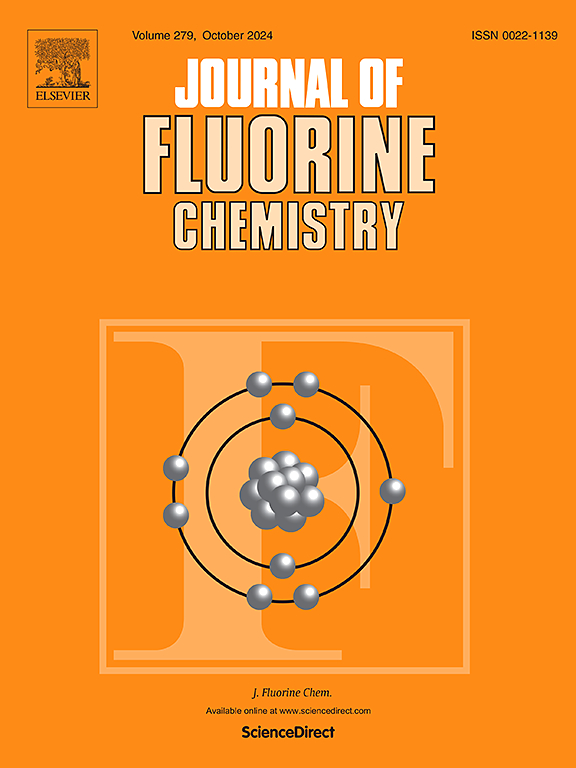Engineering perfluoroarene-arene interactions in coumarin-1,2,3-triazole-arene hybrid molecules
IF 1.7
4区 化学
Q3 CHEMISTRY, INORGANIC & NUCLEAR
引用次数: 0
Abstract
In this work, we describe the synthesis and characterization of five hybrid molecules combining coumarin, 1,2,3-triazole, and arene or perfluoroarene units (compounds 5a, 5b, 6a, 6b, and 7). Crystallization conditions of these compounds were explored, and single crystals of compounds 5b and 7 (as a dioxane solvate, 7.DIOX) were obtained. X-ray diffraction analysis revealed the presence of perfluoroarene–arene (ArF···Ar) interactions that govern the solid-state packing of both structures, leading to rod-like stacking in 5b and layered arrays in 7·DIOX. The ArF···Ar contacts were associated with centroid-to-centroid distances between 3.8 and 4.1 Å. Thermal analysis (TGA-DSC) confirmed that all compounds maintain structural integrity at high temperatures; 7·DIOX retained its crystallinity up to 150 °C before solvent loss. Powder X-ray diffraction confirmed the formation of pure crystalline phases under the employed recrystallization conditions. Additionally, preliminary solid-state fluorescence studies showed modest emission for all coumarin-containing compounds (5a, 5b, and 7·DIOX), with red-shifted maxima and variable quantum yields potentially influenced by non-covalent interactions in their molecular packing. These results underscore the utility of perfluoroarene–arene interactions in directing solid-state organization in fluorinated hybrid molecules.

香豆素-1,2,3-三唑-芳烃杂化分子中的全氟芳烃-芳烃相互作用
在这项工作中,我们描述了五个结合香豆素,1,2,3-三唑和芳烃或全氟芳烃单元的杂化分子的合成和表征(化合物5a, 5b, 6a, 6b和7)。研究了这些化合物的结晶条件,得到了化合物5b和7的单晶(二氧六环溶剂化物,7. diox)。x射线衍射分析显示,全氟芳烃-芳烃(ArF··Ar)相互作用的存在控制了这两种结构的固态堆积,导致5b中的棒状堆叠和7·DIOX中的层状阵列。ArF···Ar接触与质心距离在3.8 ~ 4.1之间相关Å。热分析(TGA-DSC)证实所有化合物在高温下保持结构完整性;7·在溶剂损失之前,DIOX的结晶度可保持到150°C。粉末x射线衍射证实在所采用的再结晶条件下形成了纯晶相。此外,初步的固态荧光研究表明,所有含香豆素的化合物(5a、5b和7·DIOX)都有适度的发射,其红移最大值和可变量子产率可能受到其分子包装中的非共价相互作用的影响。这些结果强调了全氟芳烃-芳烃相互作用在指导氟化杂化分子的固态组织中的效用。
本文章由计算机程序翻译,如有差异,请以英文原文为准。
求助全文
约1分钟内获得全文
求助全文
来源期刊

Journal of Fluorine Chemistry
化学-无机化学与核化学
CiteScore
3.80
自引率
10.50%
发文量
99
审稿时长
33 days
期刊介绍:
The Journal of Fluorine Chemistry contains reviews, original papers and short communications. The journal covers all aspects of pure and applied research on the chemistry as well as on the applications of fluorine, and of compounds or materials where fluorine exercises significant effects. This can include all chemistry research areas (inorganic, organic, organometallic, macromolecular and physical chemistry) but also includes papers on biological/biochemical related aspects of Fluorine chemistry as well as medicinal, agrochemical and pharmacological research. The Journal of Fluorine Chemistry also publishes environmental and industrial papers dealing with aspects of Fluorine chemistry on energy and material sciences. Preparative and physico-chemical investigations as well as theoretical, structural and mechanistic aspects are covered. The Journal, however, does not accept work of purely routine nature.
For reviews and special issues on particular topics of fluorine chemistry or from selected symposia, please contact the Regional Editors for further details.
 求助内容:
求助内容: 应助结果提醒方式:
应助结果提醒方式:


